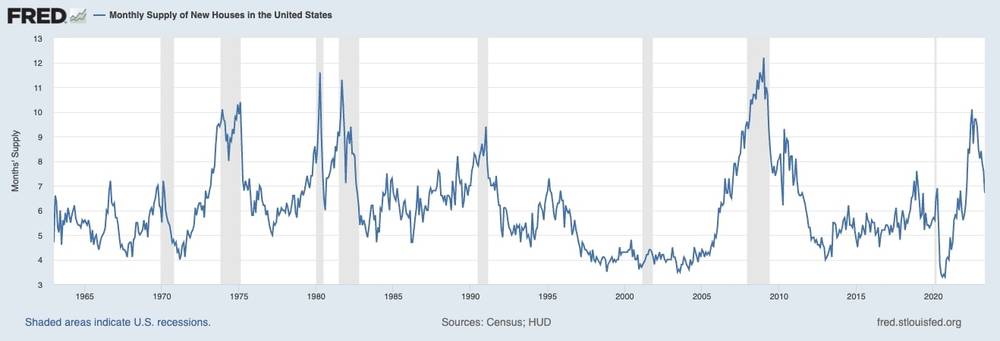It’s been generally accepted in real estate that a “balanced market” has about six months of inventory. In other words, the sales for that month equal one-sixth of the number of listed properties, so, all things being equal, it will take six months to clear that inventory. As Norada Real Estate Investments puts it,
“As a general rule, 5 to 6 months of inventory is considered to be a normal or balanced market. Over 6 months of inventory and we have a buyer’s market. If it is less than 5 months and we have a seller’s market.”
Even the National Association of Realtors states that “Historically, six months of supply is associated with moderate price appreciation.”
What’s immediately odd about this is that housing prices have fallen since last year despite what should be a seller’s market. In May 2023, prices were down 2.2% nationally from their peak in June 2022. At the same time, inventory was only half that of a “balanced market,” sitting at 3.0 months in May of 2023.
Indeed, just looking at the average days on market in Jackson County, Missouri (the largest county in the Kansas City metro area, where I invest), it becomes plainly obvious that inventory is quite low. It hasn’t taken over a month on average to get a property under contract since before the pandemic.

Nationwide, the trend isn’t much different. In May 2023, the median time on market for a listed property was just 43 days and hadn’t been over three months in many years.
Gauging This Market is Tough
Now admittedly, this is an odd market, and that may explain part of why prices are falling despite it being a “seller’s market,” given the amount of inventory available. Prices were rising at unheard-of levels prior to the rate hikes last year. Those rate hikes made it much more expensive to buy a home for anyone using debt, which thereby put downward pressure on prices. Yet, because the vast majority of homeowners have low-interest, fixed mortgages, there is little motivation to sell. Thus, while there are fewer buyers at these prices with these rates, new listings are down sharply, which buoys home prices by keeping supply low.
This dynamic is quite odd, to say the least.
Still, one would expect that if a “balanced market” were six months of inventory and such a market tended to bring about “moderate price appreciation,” and instead, actual inventory was half of that, prices would rise or, at the absolute minimum, not fall.
And remember, prices have fallen in nominal terms. In real terms (taking inflation into account), they’re down by about 10%.
It would thereby seem that our idea of what a “balanced market” is needs adjusting.
Part of the problem may be that historically speaking, the average supply of inventory for new home sales has indeed been about six months, if not more.

However, most home sales aren’t new construction. “Existing homes, unlike new homes, are homes that are owned and occupied before coming onto the market.” And such sales paint a very different picture. (Oddly, though, the Fed’s data for the monthly supply of existing homes only goes back to May 2022.)
And as far as evaluating the housing market, existing home sales are a better indicator than new home sales. In March 2023, for example, the annualized rate of existing home sales was 4.43 million. The annualized rate for new home sales was only 683,000. And if anything, the gap between the two is normally bigger.
Fortunately, Bill McBride over at Calculated Risk has the long-term data on existing home inventory. And as you can see, since the beginning of the century, with the exception of the Great Recession and its immediate aftermath, the inventory (red line) has barely ever exceeded 4 months.

One could counter that the real estate market has been hot for a while now and was certainly hot in the early aughts prior to the 2008 financial crisis. So just because the past 20 years have mostly been around four months of inventory or less, that may just be because the market was mostly a seller’s market for the last 20 years.
There is some truth to this, but still, isn’t it a bit odd that the only time this century that housing inventory exceeded a “balanced market” was in a real estate-driven financial crisis worse than anything seen since 1929? This strongly implies our concept of a “balanced market” is a month or so higher than it ought to be.
There is also another problem. Prices and inventory aren’t nearly as correlated as we would think. During the financial crisis, median home prices peaked in Q1 of 2007 and then hit their trough in Q1 of 2009 before rising almost without interruption afterward. Yet, inventory levels didn’t fall below six months until 2012.
Then, as of now, home price appreciation and the inventory levels associated with a buyer’s and seller’s market were inverse. The same was also true in most of 2006.
Conclusion
Of course, no rule of thumb is ever going to be exact when it comes to explaining a market. There are too many factors involved in a complex economy such as ours for any one rule to do that.
That being said, it should be clear that one, a “balanced market,” is probably closer to four or at most five months of inventory than the normally asserted six months, and two, the number of months of inventory is of limited value when it comes to understanding prices.
Get the Best Funding
Quickly find and compare investor-friendly lenders who specialize in your unique investing strategy. It’s fast, free, and easier than ever!
Note By BiggerPockets: These are opinions written by the author and do not necessarily represent the opinions of BiggerPockets.

